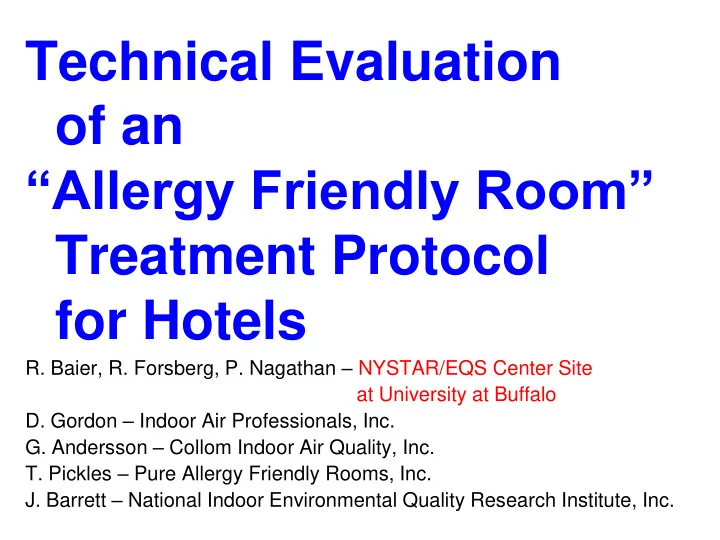

Technical Evaluation of an “Allergy Friendly Room” Treatment Protocol for Hotels R. Baier, R. Forsberg, P. Nagathan – NYSTAR/EQS Center Site at University at Buffalo D. Gordon – Indoor Air Professionals, Inc. G. Andersson – Collom Indoor Air Quality, Inc. T. Pickles – Pure Allergy Friendly Rooms, Inc. J. Barrett – National Indoor Environmental Quality Research Institute, Inc.
A “PURE” treatment protocol has been proposed for rendering hotel spaces sufficiently free of indoor air pollutants, that even environmentally-sensitive room occupants can work and rest productively while maintaining good health. In a recent independent test series at the Hampton Inn (adjacent to the University at Buffalo), the proposed protocol was implemented and monitored by multiple indoor and outdoor air quality measures of respirable particulates and gases that might trigger allergic responses or exacerbate asthma problems. Data were collected before, during, and after room treatment. Follow-up data were recorded at the 30- day and 90-day post-treatment dates.
Analytical techniques included multiple-internal reflection infrared spectroscopy, respirable particle counts, ozone measurements, and scanning electron microscopy with energy-dispersive X-ray analysis. Results indicated that the treated hotel room became and remained at least 3 times “cleaner” than the outdoor air on each sampling occasion. The PURE process included surfactant-assisted disinfection (deep rug) and fabric vacuuming, air conditioner cleaning/disinfection, aminosilane-based barrier film “fogging”, extensive ozonization of the room volume, final HEPA vacuuming of all surfaces, and installation of an ionization-based air purifier.
An unexpected finding was the ozone-induced de novo formation of fine nitrosylated aerosols within the just-cleaned air space. These quickly resolved after the ozone treatment stopped, and were not persistent at the final steps of room treatment (replacement of all the bed linens with pure, allergy-free cotton fabrics and replacement of the shower head with a dechlorination unit). Room selection by hotel visitors strongly favors this treatment protocol.
Treatment pre-analysis baseline Day Outside the Room before initiation organic carbonates of treatment inorganic hydroxylated carbonates compounds nitrates sulfates respirable particulates in outside air – silicates before room cleaning
Outside Air before room treatment
Treatment Day Inside the pre-analysis baseline Room before initiation of treatment note additional hydrocarbon contaminants respirable particulates (not present in in room air – outdoor air before treatment sample)
Inside Room before room treatment Note large “lint” fragments Note presence of copper in room aerosol before treatment
Outside Air at completion of treatment
Treatment pre-analysis baseline Day Outside the Treated Room after completion of ammonium carbonates compounds treatment respirable particulates sulfates in outside air – after room cleaning
Day 1 Inside the Treated pre-analysis baseline Room minimal residual carbonates and sulfates no residual hydrocarbons respirable particulates in room air – morning after treatment
Room aerosol deposits collected during ozonization small amount of copper detected in otherwise organic agglomerates
Air sample ammonium during and 11 days after carbonate sulfate ozone treatment nitrate of the room air. during ozone treatment (fine aerosol) note loss (sublimation) of nitrosylated particulate pre-analysis baseline same sample, 11 days later
Inside the Room after air conditioner cleaning activity see infrared aside from some spectrum for source agglomerates, room air was of phosphorus generally respirable-particle- free after treatment
pre-analysis baseline Infrared spectral identification of phosphate-rich particulate matter generated from microbiocide used to clean air conditioner microbiocide in room
Day 30 Outside the Treated pre-analysis baseline Room ammonium compounds carbonates sulfates respirable particulates in outside air –
Outside Air 30 days after treatment
Inside the Room 30 days after treatment
Day 30 Inside the pre-analysis baseline Treated Room respirable particulates in room air – 30 days after treatment
Outside Air 90 days after treatment
Inside the Room 90 days after treatment Note cotton fiber fragments
Day 90 Inside Air respirable particulates in room air – 90 days compared to after treatment Outside Air respirable particulates in outside air – 90 days after treatment of room
Recommend
More recommend